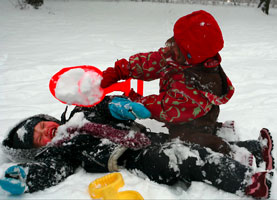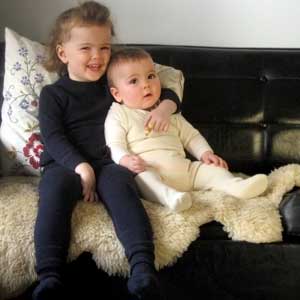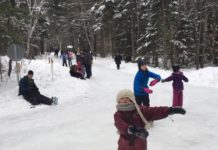No bad weather, only bad clothing
Dressing right for the weather is the key to enjoying outdoor adventures both for adults and children. For the active outdoor adult, it has long been the consensus that layering is the best system for comfort and warmth. With multiple layers you can adjust the combination to the weather and the level of exertion and changes in temperature.
Dress for activity level
As adults we dress for our activity level and the weather we are in. Someone who is x-country skiing dresses differently than a person out in the cold not exerting themselves very much. Children can be both in the course of an afternoon outside. Proper layers can keep children warm when they are inactive, but wick away sweat and water vapor away from the body towards the outer layer where it can either escape or at least not interfere with the layers trapping body heat.
The inner layer (what you mom used to call long johns and shirt) the purpose of the inner layer is to keep you warm and to allow water vapor to escape and wick moisture away from your body so you don’t get cold and wet.
The middle layer must be warm and insulating – suitable for low level activities as well as for high activities.
The outer layer should be windproof, water-resistant but still allow water vapor to escape (breath).
 Always wear hat
Always wear hat
Always wear a hat; the head looses a lot of body heat. A hat should be windproof and cover the ears. Also insure you cover their necks. We love to use mock turtlenecks instead of scarves. They stay on and don’t pose any risk of getting caught on something.
Boots and wool socks
Make sure the feet are covered with good socks (wool, blend or synthetic fiber) and that the boots are big enough so they can wiggle their feet. Make sure the boots are waterproof.
Snowsuit or two piece suit
What is best for children one piece or two piece suit? A one-piece suit is best for small children
(0-5 years old) because it generates heat and you don’t have any gaps where snow or cold air can sneak in. It also creates better movement, more activity and the need for fewer layers, which makes it easier for children to move around. Choose a snowsuit that is not too big and puffy for small children. Big puffy snowsuits make it hard for children to move around. Make also sure the snowsuit is water proof. We know the two piece suit are most popular among parents, because you can get more use for the jacket separately. If you choose a two piece suit, look for bib pants, covering the chest. This way you get less gaps where snow and cold air can sneak in.
 Optimal materials for inner layer and middle layer
Optimal materials for inner layer and middle layer
1.Merino wool
2.Synthetic fiber
3.Blend of wool and synthetic fiber
Wool
The proper layers of wool can keep kids warm when they are inactive but wick away sweat and water vapor away from the body towards the outer layer where it can either escape or at least not interfere with the layers underneath trapping body heat. Man-made fabrics don’t perform well with sweat and water vapor and cotton is even worse. Wool can in some cases absorb up to 18% to 35% of its own weight in water and still retain its insulative value.
It also wicks the excess moisture away from your body. Wool is back and it does not itch any more, thanks to new technology in weaving and utilizing the finest quality wool. – Merino wool. Wool is natures insulation, and is the best options for an inner layer. One disadvantage of wool it is more delicate then synthetic fiber, and it tears apart more after use and washing.
Synthetic fiber
Synthetic fiber underwear does allow water vapor out but has trouble wicking excess sweat away from the skin and loses its insulating properties when wet. Synthetic fiber is also suitable as a middle layer. Synthetic fiber is more robust than wool and can take more punishment both in the world and the washing machine.
Blends of wool
Blends of wool and synthetic fiber have a mixture of advantages and disadvantages like synthetic fiber and wool.
Cotton
We don’t recommend cotton is as an inner layer. Cotton absorbs moisture and holds it next to your skin. Wet cotton doesn’t trap body heat and actually works against you as the liquid in the cotton garment evaporates. When the fluid evaporates, it creates a cooling effect and your body temperature will drop.
Look for :
Long johns
Long sleeve undershirt
Wool socks
Neck warmer
Hat
Snowsuit or snow pants with bib and jacket
Waterproof mittens (mittens are warmer than gloves)
Boots
PSSt..No bad weather, only bad clothing : Boots
Bah, Bah Black Sheep, Have you any Wool?
Be safe and be see this time of year make sure you are visible wear safety reflectors








